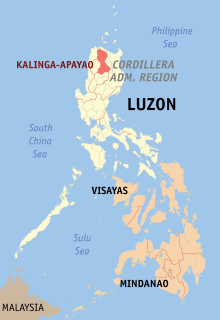Kalinga-Apayao
Kalinga-Apayao was a province of the Philippines in the Cordillera Administrative Region in the island of Luzon. It was divided into the two provinces of Kalinga and Apayao with the passage of Philippine Republic Act No. 7878 on February 14, 1995. This RA amended the earlier Republic Act No. 4695, passed on June 18, 1966, which formed the provinces of Kalinga-Apayao, Benguet, Ifugao, and Mountain Province, from the earlier Mountain Province.
| Kalinga-Apayao | |||||||||||
|---|---|---|---|---|---|---|---|---|---|---|---|
| Former province of the Philippines | |||||||||||
| 1966-1995 | |||||||||||
 Location of the historical province of Kalinga-Apayao. | |||||||||||
| Capital | Tabuk | ||||||||||
| History | |||||||||||
• Established | June 18, 1966 | ||||||||||
• Disestablished | February 14, 1995 | ||||||||||
| |||||||||||
| Today part of | Kalinga and Apayao | ||||||||||
As part of a cult of personality, long-time Philippine dictator Ferdinand Marcos made gradual changes to the borders of Kalinga-Apayao over the course of his rule with the aim of making the outline of the province, on a map, resemble the silhouette of his own head, facing towards his own native province of Ilocos Norte. The plan was unfinished when Marcos was overthrown in 1986.[1]
References
- "Marcos Drang nach Unsterblichkeit". Der Spiegel, issue 3/1989 (16 January 1989).